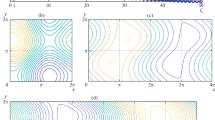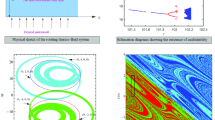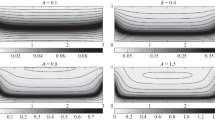Summary
For a truncated triadic model of the barotropic vorticity equation of two-dimensional rotating fluid the mechanism of successive bifurcations to chaotic attractors is evidentiated. It is suggested that the transition to chaos takes place through a Feigenbaum sequence.
Similar content being viewed by others
References
E. N. Lokenz:J. Almos. Sci.,19, 39 (1962).
E. N. Lokenz:J. Atmos. Sci.,20, 130 (1963).
J. A. Dutton:SIAM Rev.,24, 1 (1982).
V. Franceschini:Physica D,6, 285 (1982).
J. P. Gollub andS. V. Benson:J. Fluid Mech.,100, 449 (1980).
E. Lupini, C. Pellacani andL. Gardini:Meccanica (in press).
R. Lupini andC. Pellacani:Tellus A,36, 11 (1984).
M. J. Feigenbaum:Commun. Math. Phys.,77, 25 (1980).
Author information
Authors and Affiliations
Rights and permissions
About this article
Cite this article
Gardini, L., Lupini, E. & Pellacani, C. Transition to chaos in a three-mode model of forced, dissipative flow in a rotating fluid. Lett. Nuovo Cimento 42, 7–12 (1985). https://doi.org/10.1007/BF02739468
Received:
Published:
Issue Date:
DOI: https://doi.org/10.1007/BF02739468




